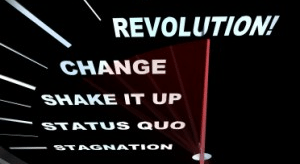The impact and the power associated with mobilizing people for a purpose are rooted in fundamental economics – they are nothing new. From electing a government official, to spreading word of and organizing an “Aquarian exhibition” of 500,000 people at Woodstock in 1969, ideating among a critical mass of people, sharing and sourcing information while leveraging the power of numbers and virality have always been present in society. Aligned crowds, we call them “smart mobs” today, are driving virtually every major trend in the global economy.
What’s new, and ever evolving, is the technology which is enabling crowds to be catalyzed, assimilated, and leveraged like never before. If we examine only the past five years, we see how rapidly the speed and power of group collaboration has increased to create value to stakeholders in ways that were previously thought unimaginable. “Technology enabled collaboration,” as its been dubbed, is in full force and effect in almost every industry on the planet. From Restaurants to Travel, and from Yelp to Orbitz, people and businesses are organizing, collaborating, sharing and peering for the purposes of lowering costs, improving quality, saving time, and even curing disease.
Another fundamental shift that has taken place over the last decade is the move from proprietary to transparent, from closed architecture to open source, from a world controlled by scarcity to one opened up by sharing. The power in business is no longer generated by those who control something, but by those who share it. I recall a friend of mine saying: “business has never been about addition or subtraction – it has always been about multiplication.” No greater multiplier exists than creating an impassioned, intentional movement based upon meeting a market driven need.
The following statement may seem counter-intuitive to many still clinging to their old-school ways, but businesses today need to understand they probably cannot control the marketplace by the uniqueness of a product or service, therefore their only choice is to empower the marketplace by adding value. Sage advice then, would be to not get sucked into the frivolity of attempting to control a market – be disruptive by opening it up.
Sustainability for businesses will be found in how quickly businesses can embrace sharing, not how long they can hold a market hostage. Few people will argue with the fact that business has, and will always be, about relationships. We can debate positional variances between qualitative, quantitative, and relational impact, but the market has ended one debate – you don’t control relationships you empower them.
Despite this movement, and hitting a bit closer to home, the commercial real estate industry seems to have been immune to the collaborative trend, and continues to operate much in the same way as it has for 20-30 years. When my firm (Sperry Van Ness) broke from the industry standard approach more than 25 years ago by adopting a set of core covenants, which gave birth to our ethos of compensated cooperation and participation with the entire brokerage community to market our inventory, we were looked at as heretics among our peers. I’m certain as time has evolved our “heretical” approach is now seen as having set the chinning bar for how the industry should operate.
The problem is that while the marketplace recognizes the benefit of the aforementioned model, the brokerage industry as a whole continues to operate with much of the same opacity, often times at the expense of the client and to the benefit of the brokerages. “Quietly” marketing properties, offering zero fee incentive for other brokers to help sell a listing, inserting eyeball roadblocks like overused registration and confidentiality requirements are still par for the course. Has any other industry been more immune to the advancements of technology enabled collaboration than commercial real estate?
When will our industry as a whole to come out of the shadows, cease with the ethereal and mercurial, embrace fundamental economic concepts like supply and demand and operate in the light of day? In the future, the market will simply not tolerate anything less than an authentic and transparent approach to business.
What say you?
– Kevin Maggiacomo, CEO & President, Sperry Van Ness International Corporation
*All Sperry Van Ness® offices are independently owned and operated.

 If you read my recent blog post about the
If you read my recent blog post about the
 If you read my recent blog post about the
If you read my recent blog post about the


 If you read my recent blog post about the
If you read my recent blog post about the
 If you read my recent blog post about the
If you read my recent blog post about the
 If you read my recent blog post about the
If you read my recent blog post about the Just being with SVN means you are a collaborator. And one could say that when you specialize in national accounts, you would naturally be a good collaborator. However, when you run your national accounts in a manner where nearly half the company writes in to nominate you, it means that you are the company’s best collaborator. As we are a company founded on collaboration both internally and externally, it’s with great pride that we present this award to
Just being with SVN means you are a collaborator. And one could say that when you specialize in national accounts, you would naturally be a good collaborator. However, when you run your national accounts in a manner where nearly half the company writes in to nominate you, it means that you are the company’s best collaborator. As we are a company founded on collaboration both internally and externally, it’s with great pride that we present this award to  If you read my recent blog post about the
If you read my recent blog post about the What can we say about
What can we say about  If you read my recent blog post about the
If you read my recent blog post about the Steve Kawulok
Steve Kawulok







 One of the hallmarks of the Sperry Van Ness® (SVN) brand is our
One of the hallmarks of the Sperry Van Ness® (SVN) brand is our 






